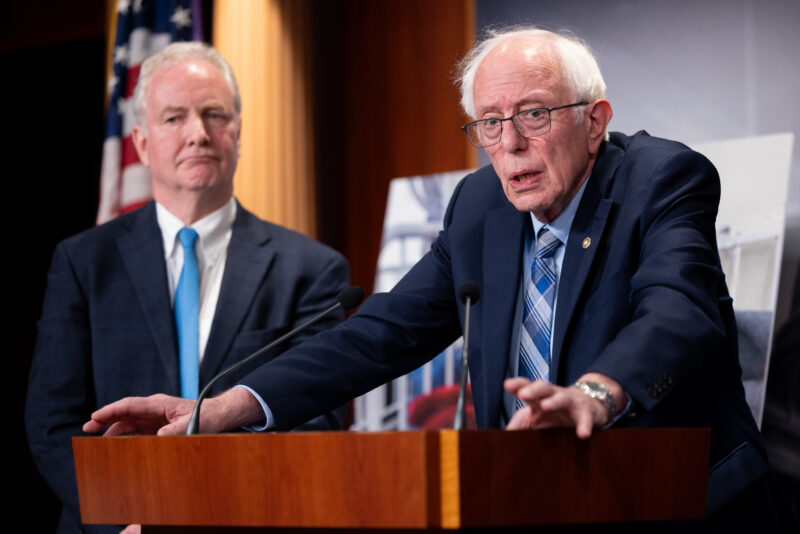Former Biden Middle East envoy blames Israel for humanitarian crisis in Gaza
U.S. special envoy for Middle East humanitarian issues David Satterfield says the Rafah operation ‘upended’ progress in increasing aid; Israeli agency COGAT points to efforts to keep aid flowing

Tom Williams/CQ Roll Call
David Satterfield, acting Assistant Secretary of State for Near Eastern Affairs, testifies during a Senate Foreign Relations in Dirksen Building titled "U.S. Policy in Syria Post-ISIS," on January 10, 2018.
The American official who spent months seeking to increase humanitarian assistance to Gaza criticized Israel for the beleaguered territory’s humanitarian crisis, claiming Israel’s partial operation in Rafah in May “upended” any progress that Israel had made in increasing humanitarian aid to Gaza.
David Satterfield, whom President Joe Biden named the U.S. special envoy for Middle East humanitarian issues just eight days after the Oct. 7 Hamas attacks, described his view of the state of humanitarian assistance in Gaza in an interview with Jewish Insider on Monday. He directed much of the blame at Israel for paying more attention to its military goals than the needs of Gazan civilians, taking a tougher line than most other senior U.S. officials who have served in public-facing roles after Oct. 7.
“A level equal to that applied to the kinetic campaign needs to be applied to humanitarian efforts — that was President Biden’s explicit message when he visited Israel after Oct. 7,” Satterfield said in a conversation on the sidelines of the MEAD Summit in Washington. “That has not in practice been the case, although it was getting significantly better by May 7. It was the Rafah campaign that has fundamentally upended all of this.”
Between October and early May, when Israel began its operation in Rafah, Satterfield observed that the humanitarian assistance getting into Gaza “mounted progressively on an almost constant curve.”
But, he added, “that was entirely disrupted as of the evening of May 7. It remains significantly disrupted as of today,” said Satterfield. “To give you raw numbers, the amount of humanitarian assistance that moves into Gaza on an average week-on-week basis is at about one quarter of what was moving before May 7.”
Data from COGAT, the Israeli agency tasked with distributing humanitarian assistance in Gaza, says otherwise.
While humanitarian assistance entering Gaza thus far in September is lower than it was in the days before the Rafah invasion, the data from COGAT does not indicate such a severe disparity. About two-thirds as much humanitarian assistance entered Gaza in the first week of September as in the week before May 6. Similarly, the amount of aid that entered Gaza in August was about two-thirds the amount that entered Gaza in April. COGAT told JI that Satterfield’s claim was incorrect. “For example, 133,000 tons of humanitarian aid entered in May, and 113,000 tons entered in July, compared to 65,000 tons in February and 103,000 tons in March,” COGAT said in a statement to JI. Satterfield stuck by his figure, telling JI in an email that it came from a nightly call that is attended by humanitarian officials from the U.S., the U.N., Egypt and COGAT.
Satterfield blamed the disruption, again, on Israel — and in particular, on Israel not successfully evacuating Rafah. He did not acknowledge that Israel significantly limited the scope of its operation following pressure from the Biden administration.
“In the end, when the campaign began, there were no alternate routes, and there was zero, zero, preparation, any more than there had been meaningful preparation for the previous displacements of one and a half million people,” said Satterfield. “Gaza is a humanitarian disaster. It was being mitigated as of the beginning of May. That mitigation stopped.”
In contrast, COGAT told JI that “Even after the start of the military activity against Hamas terror infrastructure in Rafah, the State of Israel acted proactively in order to provide solutions for the continued introduction of aid on the same scale. The trucks that previously entered the Gaza Strip from Egypt through the Rafah Crossing moved to the Kerem Shalom Crossing, and thus we allowed and renewed the entry of aid trucks from Egypt into the Gaza Strip through the Kerem Shalom Crossing.”
“Additionally, we would like to emphasize that the Kerem Shalom crossing is operating at full capacity as part of Israel’s ongoing efforts to facilitate the delivery of humanitarian aid to the Gaza Strip, and International organizations are encouraged to bring in even more aid from Egypt through this crossing than is currently bringing,” COGAT said in its statement.
“Furthermore, in cooperation with the IDF and COGAT, repair works have been done on the routes adjacent to the Kerem Shalom Crossing to facilitate traffic and allow safer and more accessible travel. In addition, in preparation for the activity in Rafah, Israel proactively encouraged international organizations and countries to bring in humanitarian aid from Israel and Judea and Samaria. Israel has also permitted the private sector to deliver food into the Gaza Strip for the benefit of the civilian population, while prioritizing aid from international organizations and countries.”
A retired senior Foreign Service Officer who previously served as U.S. ambassador to Turkey and Lebanon, Satterfield was based in Tel Aviv during the six months he served as special envoy. He did not visit Gaza in that period: “There are no American officials in Gaza,” Satterfield said.
Instead, he trusted the assessments of humanitarian partners in Gaza, including the United Nations and charitable organizations such as the World Food Programme.
“We spoke with U.N. officials in Gaza on an almost daily basis, sometimes multiple times a day. They were there on the ground, describing to us what was happening,” said Satterfield, who has now returned to his day job as the director of the Baker Institute for Public Policy at Rice University.
Over the past year, COGAT at times clashed with U.N. agencies who accused Israel of saying it was sending in more aid than it actually did — charges COGAT denied.
Using diplomatic language, Satterfield expressed frustration with the way Israeli officials sometimes talked about the humanitarian situation, though he kept his vexation fixed on senior officials who were not on the ground (presumably taking COGAT out of the picture).
“Just as certain officials not on the ground who used broad, assertive language to describe the situation that we believe did not reflect what their own staffs were reporting on the ground,” said Satterfield, “so statements have been made, were made by Israeli officials, which, frankly, did not correspond with reality as we understood them.”
Congress voted in March to bar funding for the United Nations Relief and Works Agency (UNRWA) after the agency revealed that a dozen of its employees were involved in the Oct. 7 Hamas terror attacks in Israel. Satterfield declined to comment on the funding ban, but said it would be hard for the U.S. to find another agency to support with the same capabilities as the embattled U.N. agency.
“There is, at this date, no immediate or short-term alternative,” said Satterfield. “The logistics capacity of UNRWA was not just unmatched by any other agency, U.N. or other on the ground in Gaza. It dominated by an exponential scale over time.”
COGAT told JI that while Israel “continues to take significant steps to assist the international community in expanding the scope of aid deliveries, improving logistical capabilities, and facilitating the movement of aid,” it charged that the U.N. “does not collect and distribute humanitarian aid to the residents of Gaza in a continuous and effective manner.”
The Israeli agency also pointed out that aid crossings were temporarily closed several times due to rocket fire attacks by Hamas, “aimed at hindering the entry of aid into Gaza. Hamas’s targeted rocket fire at the Kerem Shalom crossing endangered the lives of workers on both sides, disrupted regular operations, and forced the temporary closure of the crossing, thereby impeding the delivery of humanitarian aid.”
The only solution, Satterfield said, is a cease-fire.
“What is to be done? It is because of the situation, which grows not static or stable but worse with repeated IDF reevaluation and reevaluation almost continuous until two weeks ago,” said Satterfield. “What has to be done is a cease-fire.”
Washington officials have taken a more pessimistic tone toward cease-fire-and-hostage deal talks this week, blaming Hamas for adding new conditions. “It’s still worth an effort to try to see if we can’t get back into a cease-fire negotiation. But we’re not there right now,” White House national security spokesperson John Kirby said on Tuesday.
Satterfield acknowledged the difficulty of reaching a deal, particularly after “horrific actions by Hamas, the execution of the six [hostages]” last month.
“You keep working the issue, because there is no other means,” said Satterfied. A consummate diplomat, he quoted the architect of the Good Friday Agreement that brokered peace in Northern Ireland in the 1990s who offered a famous quote about diplomacy.
“Negotiations are like this more often than they’re not. They are, as has been famously said by George Mitchell about the Northern Ireland negotiations, 700 days of failure, one day of success,” said Satterfield. “You work for the one day of success.”
Friday marks 343 days since Hamas invaded Israel, and 342 days that the terror group has held hostages in tunnels underneath the Gaza Strip — including in Rafah.
Jewish Insider’s Tamara Zieve contributed to this report.











































